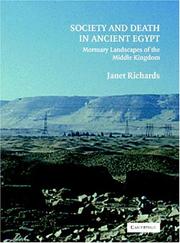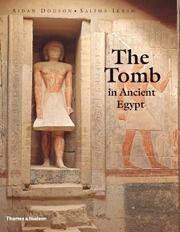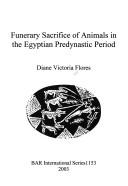| Listing 1 - 10 of 67 | << page >> |
Sort by
|
Book
Year: 1926 Publisher: London : T. Werner Laurie,
Abstract | Keywords | Export | Availability | Bookmark
 Loading...
Loading...Choose an application
- Reference Manager
- EndNote
- RefWorks (Direct export to RefWorks)
Book
Year: 1984 Publisher: Harmondsworth ; New York ; Ringwood ; Markham ; Auckland : Penguin Books,
Abstract | Keywords | Export | Availability | Bookmark
 Loading...
Loading...Choose an application
- Reference Manager
- EndNote
- RefWorks (Direct export to RefWorks)
Stimulatin, scholarly and beautifully illustrated, this Pelican offers the general reader an accessible account of Egyptian burial customs, the reasons for their existence and how they changed in response to developments in religion. Drawing on his extensive knowledge of this field, A. J. Spencer describes the tombs and the objects inside them - furniture, food, inscriptions, temples for animal gods - and shows how the Egyptians wrestled with the ever-pressing security problems in guarding the afterlife of their dead. He goes on to demonstrate how recent scientific developments have added an exciting new dimension to research, enabling researchers to trace family relationships, identify prevalent diseases and sometimes to discover the full pathological case histories of mummies to produce an extraordinary detailed picture of this most fascinating of cultures.
Book
ISBN: 9781789252620 1789252628 Year: 2019 Publisher: Oxford ; Philadelphia : Oxbow Books,
Abstract | Keywords | Export | Availability | Bookmark
 Loading...
Loading...Choose an application
- Reference Manager
- EndNote
- RefWorks (Direct export to RefWorks)
"Egyptian coffins stand out in museums' collections for their lively and radiant appearance. As an involucre of the mummy, coffins played a key-role by protecting the body and at the same time, integrating the deceased in the afterlife. The paramount importance of these objects and their purpose is detected in the ways they changed through time. For more than three thousand years, coffins and tombs had been designed to assure in the most efficient way possible a successful outcome for the difficult transition to the afterlife. This book examines twelve non-royal tombs found relatively intact, from the plains of Saqqara to the sacred hills of Thebes. These almost undisturbed burial sites managed to escape ancient looters and became adventurous events of the Egyptian archaeology. These discoveries are described from the Mariette's exploration of the Mastaba of Ti in Saqqara to Schiaparelli's discovery of the Tomb of Kha and Merit in Deir el-Medina. Each one of these sites unveil before our eyes a time capsule, where coffins and tombs were designed together as part of a social, political, and religious order. From the Pre-dynastic times to the decline of the New Kingdom, this book explores each site revealing the interconnection between mummification practices, coffin decoration, burial equipment, tomb decoration and ritual landscapes. Through this analysis, the author aims to point out how the design of coffins changed through time in order to empower the deceased with different visions of immortality. By doing so, the study of coffins reveal a silent revolution which managed to open to the common men and women horizons of divinity previously reserved to the royal sphere. Coffins thus show us how identity was forged to create an immortal and divine self"-- Provided by publisher.
Book
Year: 1960 Publisher: Genève : Droz,
Abstract | Keywords | Export | Availability | Bookmark
 Loading...
Loading...Choose an application
- Reference Manager
- EndNote
- RefWorks (Direct export to RefWorks)
Rites et cérémonies funéraires --- Rois et souverains --- Mort

ISBN: 9780521119832 9780521840330 0521119839 Year: 2009 Publisher: Cambridge ; New-York : Cambrisge University Press,
Abstract | Keywords | Export | Availability | Bookmark
 Loading...
Loading...Choose an application
- Reference Manager
- EndNote
- RefWorks (Direct export to RefWorks)
Book
ISBN: 9788418979330 841897933X 9788418979996 8418979992 Year: 2022 Publisher: Alcalá de Henares : Editorial Universidad de Alcalá,
Abstract | Keywords | Export | Availability | Bookmark
 Loading...
Loading...Choose an application
- Reference Manager
- EndNote
- RefWorks (Direct export to RefWorks)
Ancient Egyptian mortuary cult is one of the most fascinating subjects for whoever approaches ancient Egypt and a recurrent topic in previous and current research on ancient Egyptian beliefs and practices. One key aspect for understanding the mortuary cult is, doubtlessly, its agents, the 'priestly officiants' that once performed the rites with the ultimate expectation to ensure an escape from death for the deceased. Despite their significant role, there are not many works particularly devoted to the mortuary 'priesthood' in ancient Egypt, and even less for a period as remote as the Old Kingdom. In view of this, Priestly officiants in the Old Kingdom mortuary cult aims at filling the gap in the Egyptological literature by incorporating into the discussion comprehensive analyses of eight of the most prominent priestly titles of the period. Thus, the main goal is to consolidate our insight of the role of those who guarded, developed, and sustained the most professional duties involved in the respect and care for the dead and their memory. The most noteworthy figures in the mortuary cult from both private and royal domains are the subject of a thorough examination covering the nature and development of each title, its functions and domains of practice, the most critical sources for their study and its historical evolution with a fresh approach that incorporates the newest theories and positions in the study of the Old Kingdom mortuary officialdom.
Funeral rites and ceremonies --- Priests --- Inscriptions, Egyptian. --- Prêtres --- Égyptiens --- Rites et cérémonies funéraires --- History. --- Mort --- Égypte --- Prêtres -- Égypte --- Rites et cérémonies funéraires égyptiens --- Prêtres --- Égyptiens --- Rites et cérémonies funéraires --- Égypte
Book
ISBN: 9781072196037 Year: 2019 Publisher: [S.l.] SPBDStudies
Abstract | Keywords | Export | Availability | Bookmark
 Loading...
Loading...Choose an application
- Reference Manager
- EndNote
- RefWorks (Direct export to RefWorks)
Égyptien ancien (langue) --- Inscriptions égyptiennes. --- Incantations égyptiennes anciennes. --- Rites et cérémonies funéraires égyptiens. --- Papyrus égyptiens. --- Antiquités --- Livre des morts. --- Égypte

ISBN: 0500050880 Year: 1998 Publisher: Londres Thames and Hudson
Abstract | Keywords | Export | Availability | Bookmark
 Loading...
Loading...Choose an application
- Reference Manager
- EndNote
- RefWorks (Direct export to RefWorks)
Mummies --- Funeral rites and ceremonies --- Momies --- Funérailles --- Rites et cérémonies --- Funérailles --- Rites et cérémonies --- Tombes --- Embaumement --- Rites et cérémonies funéraires égyptiens --- Égypte --- Antiquité

ISBN: 9780500051399 0500051399 Year: 2008 Publisher: Londres Thames and Hudson
Abstract | Keywords | Export | Availability | Bookmark
 Loading...
Loading...Choose an application
- Reference Manager
- EndNote
- RefWorks (Direct export to RefWorks)
Tombs --- History --- History. --- Egyptians --- Tombes --- Egyptiens --- Funeral customs and rites --- Histoire --- Rites et cérémonies funéraires --- Rites et cérémonies funéraires --- Tombs - Egypt - History

ISBN: 1841715239 Year: 2003 Publisher: Oxford : Archaeopress : Available from Hadrian Books,
Abstract | Keywords | Export | Availability | Bookmark
 Loading...
Loading...Choose an application
- Reference Manager
- EndNote
- RefWorks (Direct export to RefWorks)
Funeral rites and ceremonies --- Animal sacrifice --- Tombs --- Mastabas --- Sacrifice --- Sacrifice d'animaux --- Rites et cérémonies funéraires égyptiens --- Tombes --- Égypte --- Antiquité --- Religion égyptienne
| Listing 1 - 10 of 67 | << page >> |
Sort by
|

 Search
Search Feedback
Feedback About UniCat
About UniCat  Help
Help News
News